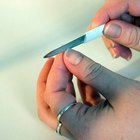icetocker/iStock/GettyImages
When you're craving baked potatoes, you want them now—not after an hour or more of baking. Instead of waiting and waiting, stick a nail through the center of each one. Potato nails are made from sturdy aluminum or stainless steel, and are specifically designed for cooking potatoes quicker than the average spud -- 15 to 20 minutes faster on average. Use these instructions to get your favorite side on the table fast.
Poking Them Through
Prick the potatoes a few times with a fork before poking the nails through the center of a scrubbed potato, lengthwise. Set the potato directly on your oven’s rack at 400 degrees Fahrenheit, until the inside is tender and the outside is cooked to your liking. The potato nail draws heat to the center of the potato, resulting in a quick, uniform bake. Slip on an oven mitt and pull the hot potato nail out of the baked potato before serving.
Baking With Variety
A true baked potato is not wrapped in aluminum foil before it hits the oven. Wrapping in foil steams the potato instead of baking it. The foil also softens the skin of the potato. If a crunchy skin is what you are looking for, ditch the foil. If you prefer a softer skin, but prefer the taste of baking without foil, apply a thin coating of butter or vegetable oil to the skin after putting the nail in the potato.
Not the Average Nail
Unlike the nails in the hardware store, potato nails are made from food-grade metals. This eliminates the possibility of unsafe metal particles leaching into the potato. Potato nails are also dishwasher safe, which means that you can sanitize them after use without worry of rusting or discoloration. Some potato nail kits come with a tool that makes the removal of the hot nail, reducing the likelihood that you will burn your fingers.
Avoid the Microwave
Fight the urge to bake potatoes in the microwave with nails driven down the center. Even if the nail is tucked inside the potato, it can still cause arcing in the microwave. The arching is actually sparks that develop as the metal absorbs the microwaves. The resulting sparks burn the sides of the microwave as they bounce back and forth looking for a way out. The end result may be a damaged microwave.
Related Articles

Baking Potatoes With Potato Nails
Does a Baked Potato Cook Faster if You ...

Ways to Cook Baked Potatoes Without Foil

Why Do You Need to Pierce Potatoes ...

How to Remove Acrylics With Acetone and ...

How to Get Acrylic Nails Off at Home ...

How to Use Raw Potato on the Face for ...

How to Bake a Potato Without an Oven

How to Round Your Nails

Cures for Acetone Damaged Nails
How to Heat Up a Potato Pancake and ...

How to Get Acrylic Off of Cuticles

How to Remove Nail Glue From Skin

How to Take Care of Nails After Acrylics

How to Regrow Nails

Calories in a Skinless Baked Potato

How to Take Off a Claire's Glue-On Nail ...

How to Take Off No-Chip Nails

How to Put an Acrylic Nail Back on ...

Can You Over-Bake a Potato?
References
- The Clever Cook's Kitchen Handbook: 5,037 Ingenious Hints, Secrets, Shortcuts and Solutions: David Joachim
- Top 100 Food Plants: Ernest Small
- Cornell Center for Materials Research: Ask a Scientist: No metal in the microwave: Aluminum foil isn't water
- 500 Treasured Country Recipes from Martha Storey and Friends: Martha Storey
Resources
Writer Bio
Jonae Fredericks started writing in 2007. She also has a background as a licensed cosmetologist and certified skin-care specialist. Jonae Fredericks is a certified paraeducator, presently working in the public education system.